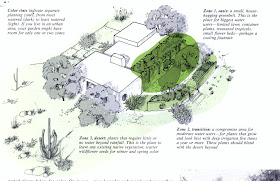Planting a Bareroot Fruit Tree
Materials
Needed:
·
Shovel
·
Predug
hole three to four feet in diameter
·
Three
to four cubic feet of compost per tree
·
Preplant
fertilizer (triple super phosphate or high in phosphorus)
·
Wooden
or metal stake at least four feet long
·
Hammer
·
Green
nursery tape
·
Whitewash
or white latex paint diluted equally with water
·
Paint
brush
·
One
24 inch X 3’ section of one-inch hexagonal chicken fencing (if rabbits a
problem)
·
Wood
mulch
·
Bypass
type hand pruner
 |
| Planting hole for fruit trees with amended soil |
2.
Reserve soil from the hole for mixing
with compost called backfill
3.
Remove rocks larger than a golf ball.
4.
Add compost to the backfill and mix
thoroughly.
5.
Add preplant fertilizer to the compost
soil mix and thoroughly mix.
6.
Place tree in the planting hole and
orient the bud union (dogleg) to the north. And make sure the roots will be ½
inch below the finished soil level when finished.
7.
Put three to four inches of amended
soil into the bottom of the hole and start adding water. The water should turn
the soil into a slurry (consistency of a milk shake) and flow around the roots,
removing air pockets.
8.
Continue to add the
soil/compost/fertilizer mix to the planting hole as water is added.
9.
When the backfill has been added completely,
collapse the edges of the planting hole with your shovel to create an
irrigation basin for watering. This basin should be level and have a depth of
three to four inches. If a basin does not exist, create one by piling soil
around the edge of the planting hole to create a moat.
10. Once
the tree has been planted and the water has drained, check to make sure no
roots are exposed. Draining may take anywhere from minutes in well drained
soils to hours in poorly drained soils. If the roots are exposed, cover the
roots with amended soil but be careful to leave a three to four inch deep,
level basin (moat) surrounding the tree and encircling the planting hole.
.JPG) |
| Fruit tree watered in but missing the stake to hold the roots from moving |
11. Drive
a four foot or longer stake with a hammer into the hole directly next to the
tree. Make sure the stake is solidly driven into the soil at the bottom of the
hole. The stake should be immobile after it is driven into the bottom of the
hole.
12. Using
green, pliable nursery tape, tie the tree tightly to the stake so that the tree
is immobilized. When planting bareroot trees, the tree must be immobilized in
its first few months during establishment in its new home. This allows for
strong, healthy and fast root development by mid to late summer. The stake
should be removed the following spring.
13. If
the tree has not been whitewashed, then whitewash the tree using either
whitewash compounds or diluted white latex paint (half water/half white latex
paint). Paint the trunk, trunk bud union and any major stems coming from the
trunk to a distance of two inches from the trunk.
14. Spread
the wood mulch throughout the basin to a minimum of three inches. Pull the
mulch away from the trunk of the tree six inches to allow for drying of the
trunk between irrigations and avoid crown rot.
15. If
you live near the desert, golf course or park protect your new investment with
rabbit fencing. Encircle the tee with 24
inch (wide) X 3 ft (long), one inch mesh, chicken wire. Tie the ends of the
fencing together so that rabbits cannot get inside and damage the tree. Bury
the bottom edge of the fencing two inches into the mulch.
16. If
your tree does not have any limbs low to the ground, prune the main stem of the
tree at knee height if you want your fruit production as low on the tree as
possible. This will force the tree to produce branches and fruit lower to the
ground for easier picking later in its life.
17. Irrigate
the tree daily for the first three days to continue to remove air pockets. Wet
the soil surrounding the hole and settle the plant into its new home.


.JPG)

.JPG)

.JPG)







+compressed.jpg)
+compressed.jpg)
+compressed.jpg)